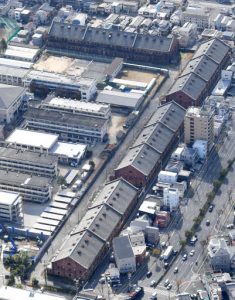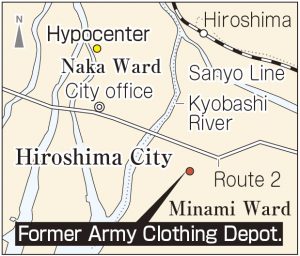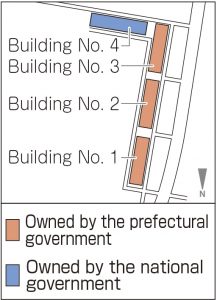Hiroshima Mayor requests Prefecture to preserve all buildings of the Former Army Clothing Depot, clearly indicating a difference in attitudes
Dec. 19, 2019
(by Junji Akechi and Koji Higuchi, Staff Writers)
On December 18, Hiroshima Mayor Kazumi Matsui held a press conference and made clear he had informed the prefecture of the city’s call for preserving all three prefecture-owned buildings of the Depo. The former Army Clothing Depot is the largest set of A-bombed buildings in Hiroshima. Hiroshima prefecture had previously announced its original plan to dismantle two buildings and preserve the other. “Once the buildings are lost, we cannot bring them back again,” said Mr. Matsui, stressing the significance of maintaining the A-bombed buildings for later generations, and illustrating the difference of attitudes between the city and prefecture.
Mr. Matsui said, “The A-bombed buildings are a silent witness that can convey the history of the atomic bombing and the terrible damage it caused.” He added, “If all of the Depot’s buildings are conserved, they could deliver the devastation of the atomic bombing on a larger scale.” He also shared the city’s recognition of the many challenges required to keep the buildings, by saying “We understand the need to take safety measures for the depot and the need to secure a source of revenue,” but then said, “We asked the prefecture to preserve each of the buildings as much as it could.”
He also mentioned that the A-bombed buildings owned by the city had been conserved with its own revenue and subsidies from the national government. As for the possibility of using the city’s financial support to keep the clothing depot, he denied it at this time, saying “Our idea is to think about what kind of cooperation we can provide, considering the prefecture’s initiative as a prerequisite.” He added the city would cooperate if the prefecture conducted a fund-raising program including donations.
On December 4, at the general affairs committee of the prefectural assembly, the prefecture explained its original proposal to keep the outer appearance of the Depot’s building No. 1 and to demolish and remove building No. 2 and No. 3. It has been gathering opinions on the proposal from citizens since December 17, and will continue to do so through January 16, next year.
Taiki Adachi, manager of the prefecture’s property administration division, said, “I have already heard the city’s call for the preservation of all three buildings during the discussion including the national government. We will indicate our final direction based on the results of our citizen opinion survey.” The prefecture will determine the direction of the Depot in February, next year.
A group of citizens who wish to preserve the former army clothing depot has requested the prefecture preserve all of the buildings. Additionally, another city group with the same aim has delivered the signatures of about 12,000 people collected on the internet to the prefecture. Movement asking for preservation of the depot has been spreading.
After the U.S. dropped the atomic bomb on Hiroshima, the former army clothing depot was used as an aid station taking in many A-bomb victims. After the war, the buildings were used for multiple purposes, including as a schoolhouse for the Hiroshima Higher Normal School (now School of Education in Hiroshima University) and as a warehouse for a private company.
Keywords
Former Army Clothing Depot
This facility was used to produce the former army’s military uniforms and combat boots. It was completed in 1913, and located 2.7 kilometers to the southeast of the hypocenter. Out of 13 warehouse buildings, four of them are now kept in the shape of the letter “L.” The prefecture owns buildings No. 1 through 3, and the Japanese government owns building No. 4. These four buildings are three-story ferroconcrete structures covered with red brick outer walls. The total square space of buildings No. 1 through 3 is 5,578 square meters, and building No. 4 is 4,985 square meters.
(Originally published on December 19, 2019)
On December 18, Hiroshima Mayor Kazumi Matsui held a press conference and made clear he had informed the prefecture of the city’s call for preserving all three prefecture-owned buildings of the Depo. The former Army Clothing Depot is the largest set of A-bombed buildings in Hiroshima. Hiroshima prefecture had previously announced its original plan to dismantle two buildings and preserve the other. “Once the buildings are lost, we cannot bring them back again,” said Mr. Matsui, stressing the significance of maintaining the A-bombed buildings for later generations, and illustrating the difference of attitudes between the city and prefecture.
Mr. Matsui said, “The A-bombed buildings are a silent witness that can convey the history of the atomic bombing and the terrible damage it caused.” He added, “If all of the Depot’s buildings are conserved, they could deliver the devastation of the atomic bombing on a larger scale.” He also shared the city’s recognition of the many challenges required to keep the buildings, by saying “We understand the need to take safety measures for the depot and the need to secure a source of revenue,” but then said, “We asked the prefecture to preserve each of the buildings as much as it could.”
He also mentioned that the A-bombed buildings owned by the city had been conserved with its own revenue and subsidies from the national government. As for the possibility of using the city’s financial support to keep the clothing depot, he denied it at this time, saying “Our idea is to think about what kind of cooperation we can provide, considering the prefecture’s initiative as a prerequisite.” He added the city would cooperate if the prefecture conducted a fund-raising program including donations.
On December 4, at the general affairs committee of the prefectural assembly, the prefecture explained its original proposal to keep the outer appearance of the Depot’s building No. 1 and to demolish and remove building No. 2 and No. 3. It has been gathering opinions on the proposal from citizens since December 17, and will continue to do so through January 16, next year.
Taiki Adachi, manager of the prefecture’s property administration division, said, “I have already heard the city’s call for the preservation of all three buildings during the discussion including the national government. We will indicate our final direction based on the results of our citizen opinion survey.” The prefecture will determine the direction of the Depot in February, next year.
A group of citizens who wish to preserve the former army clothing depot has requested the prefecture preserve all of the buildings. Additionally, another city group with the same aim has delivered the signatures of about 12,000 people collected on the internet to the prefecture. Movement asking for preservation of the depot has been spreading.
After the U.S. dropped the atomic bomb on Hiroshima, the former army clothing depot was used as an aid station taking in many A-bomb victims. After the war, the buildings were used for multiple purposes, including as a schoolhouse for the Hiroshima Higher Normal School (now School of Education in Hiroshima University) and as a warehouse for a private company.
Keywords
Former Army Clothing Depot
This facility was used to produce the former army’s military uniforms and combat boots. It was completed in 1913, and located 2.7 kilometers to the southeast of the hypocenter. Out of 13 warehouse buildings, four of them are now kept in the shape of the letter “L.” The prefecture owns buildings No. 1 through 3, and the Japanese government owns building No. 4. These four buildings are three-story ferroconcrete structures covered with red brick outer walls. The total square space of buildings No. 1 through 3 is 5,578 square meters, and building No. 4 is 4,985 square meters.
(Originally published on December 19, 2019)









